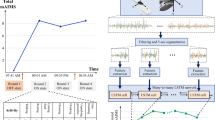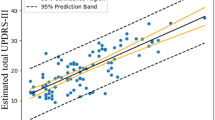Abstract
A wearable sensor system is available for monitoring of bradykinesia in patients with Parkinson’s disease (PD), however, it remains unclear whether kinematic parameters would reflect clinical severity of PD, or would help clinical diagnosis of physicians. The present study investigated whether the classification model using kinematic parameters from the wearable sensor may show accordance with clinical rating and diagnosis in PD patients. Using the Inertial Measurement Units (IMU) sensor, we measured the movement of finger tapping (FT), hand movements (HM), and rapid alternating movements (RA) in 25 PD patients and 21 healthy controls. Through the analysis of the measured signal, 11 objective features were derived. In addition, a clinician who specializes in movement disorders viewed the test video and evaluated each of the Unified Parkinson's Disease Rating Scale (UPDRS) scores. In all items of FT, HM, RA, the correlation between the linear regression score obtained through objective features (angle, period, coefficient variances for angle and period, change rates of angle and period, angular velocity, total angle, frequency, magnitude, and frequency × magnitude) and the clinician’s UPDRS score was analyzed, and there was a significant correlation (rho > 0.7, p < 0.001). PD patients and controls were classified by deep learning using objective features. As a result, it showed a high performance with an area under the curve (AUC) about as high as 0.9 (FT Total = 0.950, HM Total = 0.889, RA Total = 0.888, ALL Total = 0.926. This showed similar performance to the classification result of binary logistic regression and neurologist, and significantly higher than that of family medicine specialists. Our results suggest that the deep learning model using objective features from the IMU sensor can be usefully used to identify and evaluate bradykinesia, especially for general physicians not specializing in neurology.




Similar content being viewed by others
References
Alaskar H, Hussain A (2018) Prediction of Parkinson disease using gait signals. 11th international conference on developments in esystems engineering (DeSE):23–26. https://doi.org/10.1109/DeSE.2018.00011
Albani G, Ferraris C, Nerino R, Chimienti A, Pettiti G, Parisi F, Priano L (2019) An Integrated multi-sensor approach for the remote monitoring of Parkinson’s disease. Sensors 19(21):4764. https://doi.org/10.3390/s19214764
Bajaj NP, Gontu V, Birchall J, Patterson J, Grosset DG, Lees AJ (2010) Accuracy of clinical diagnosis in tremulous parkinsonian patients: a blinded video study. J Neurol Neurosurg Psychiatry 81(11):1223–1228. https://doi.org/10.1136/jnnp.2009.193391
Bank PJ, Marinus J, Meskers CG, de Groot JH, van Hilten JJ (2017) Optical hand tracking: a novel technique for the assessment of bradykinesia in Parkinson’s disease. Mov Disord Pract 4(6):875–883. https://doi.org/10.1002/mdc3.12536
Bologna M, Paparella G, Fasano A, Hallett M, Berardelli A (2020a) Evolving concepts on bradykinesia. Brain 143(3):727–750. https://doi.org/10.1093/brain/awz344
Bologna M, Paparella G, Colella D, Cannavacciuolo A, Angelini L, Alunni-Fegatelli D, Guerra A, Berardelli A (2020b) Is there evidence of bradykinesia in essential tremor? Eur J Neurol 27(8):1501–1509. https://doi.org/10.1111/ene.14312
Borzì L, Varrecchia M, Olmo G, Artusi CA, Fabbri M, Rizzone MG, Lopiano L (2019) Home monitoring of motor fluctuations in Parkinson’s disease patients. J Reliab Intell Environ 5(3):145–162. https://doi.org/10.1007/s40860-019-00086-x
Buongiorno D, Bortone I, Cascarano GD, Trotta GF, Brunetti A, Bevilacqua V (2019) A low-cost vision system based on the analysis of motor features for recognition and severity rating of Parkinson’s disease. BMC Med Inform Decis Mak 19(9):243. https://doi.org/10.1186/s12911-019-0987-5
Butt AH, Rovini E, Dolciotti C, De Petris G, Bongioanni P, Carboncini MC, Cavallo F (2018) Objective and automatic classification of Parkinson disease with leap motion controller. Biomed Eng online 17(1):168. https://doi.org/10.1186/s12938-018-0600-7
Castrillon R, Acien A, Orozco-Arroyave J R, Morales A, Vargas J F, Vera-Rodríguez R, Villegas A (2019) Characterization of the Handwriting Skills as a Biomarker for Parkinson’s Disease. 14th IEEE international conference on automatic face and gesture recognition (FG 2019):1–5. https://doi.org/10.1109/FG.2019.8756508
Chomiak T, Pereira FV, Meyer N, de Bruin N, Derwent L, Luan K, Hu B et al (2015) A new quantitative method for evaluating freezing of gait and dual-attention task deficits in Parkinson’s disease. J Neural Transm 122(11):1523–1531. https://doi.org/10.1007/s00702-015-1423-3
Chomiak T, Xian W, Pei Z, Hu B (2019) A novel single-sensor-based method for the detection of gait-cycle breakdown and freezing of gait in Parkinson’s disease. J Neural Transm 126(8):1029–1036. https://doi.org/10.1007/s00702-019-02020-0
Contin L, Cimolin V, Azzaro C, Albani G, Mauro A (2019) BSN-based Kinematic characterization and comparative outlook of UPDRS scoring in leg agility, sit-to-stand, and gait tasks for parkinsonians. IEEE J Biomed Health Inform 19(6):1777–1793. https://doi.org/10.1109/JBHI.2015.2472640
Dai H, Lin H, Lueth TC (2015) Quantitative assessment of parkinsonian bradykinesia based on an inertial measurement unit. Biomed Eng online 14(1):68. https://doi.org/10.1186/s12938-015-0067-8
Dorsey ER, Bloem BR (2018) The Parkinson pandemic-a call to action. JAMA Neurol 75(1):9–10. https://doi.org/10.1001/jamaneurol.2017.3299
Đurić-Jovičić M, Jovičić N, Radovanović S, Ječmenica-Lukić M, Belić M, Popović M, Kostić V (2018) Finger and foot tapping sensor system for objective motor assessment. Vojnosanit Pregl 75(1):68–77. https://doi.org/10.2298/VSP150502323D
Garza-Rodríguez A, Sánchez-Fernández LP, Sánchez-Pérez LA, Ornelas-Vences C, Ehrenberg-Inzunza M (2018) Pronation and supination analysis based on biomechanical signals from Parkinson’s disease patients. Artif Intell Medicine 84:7–22. https://doi.org/10.1016/j.artmed.2017.10.001
Greiner M, Pfeiffer D, Smith RD (2000) Principles and practical application of the receiver-operating characteristic analysis for diagnostic tests. Prev Vet Medicine 45(1–2):23–41. https://doi.org/10.1016/S0167-5877(00)00115-X
Jankovic J (2008) Parkinson’s disease: clinical features and diagnosis. J Neurol Neurosurg Psychiatry 79(4):368–376. https://doi.org/10.1136/jnnp.2007.131045
Jeong D, Baek M, Kim W, Lee SS (2018) Deep neural network vehicle trajectory prediction based on a deep neural network. Trans Korean Soc Automotive Eng 26(2):202–210. https://doi.org/10.7467/KSAE.2018.26.2.202
Khodakarami H, Ricciardi L, Contarino MF, Pahwa R, Lyons KE, Geraedts VJ, Horne M (2019) Prediction of the levodopa challenge test in Parkinson’s disease using data from a wrist-worn sensor. Sensors 19(23):5153. https://doi.org/10.3390/s19235153
LeCun Y, Bengio Y, Hinton G (2015) Deep learning. Nature 521(7553):436–444. https://doi.org/10.1038/nature14539
Lee MJ, Kim SL, Lyoo CH, Lee MS (2014) Kinematic analysis in patients with Parkinson’s disease and SWEDD. J Parkinsons Dis 4(3):421–430. https://doi.org/10.3233/JPD-130233
Lee MJ, Kim SL, Lyoo CH, Rinne JO, Lee MS (2015) Impact of regional striatal dopaminergic function on kinematic parameters of Parkinson’s disease. J Neural Transm 122(5):669–677. https://doi.org/10.1007/s00702-014-1296-x
Li N, Tian F, Fan X, Zhu Y, Wang H, Dai G (2019) Monitoring motor symptoms in Parkinson’s disease via instrumenting daily artifacts with inertia sensors. CCF Transactions Pervasive Comp Interact 1(2):100–113. https://doi.org/10.1007/s42486-019-00008-z
Ossig C, Antonini A, Buhmann C, Classen J, Csoti I, Falkenburger B, Storch A et al (2016) Wearable sensor-based objective assessment of motor symptoms in Parkinson’s disease. J Neural Transm 123(1):57–64. https://doi.org/10.1007/s00702-015-1439-8
Postuma RB, Berg D, Stern M, Poewe W, Olanow CW, Oertel W, Halliday G et al (2015) MDS clinical diagnostic criteria for Parkinson’s disease. Mov Disord 30(12):1591–1601. https://doi.org/10.1002/mds.26424
Powell HC, Hanson MA, Lach J (2009) On-body inertial sensing and signal processing for clinical assessment of tremor. IEEE TransBiomed Circuits Systems 3(2):108–116. https://doi.org/10.1109/TBCAS.2008.2006622
Ricci M, Di Lazzaro G, Pisani A, Mercuri NB, Giannini F, Saggio G (2019) Assessment of motor impairments in early untreated Parkinson’s disease patients: the wearable electronics impact. IEEE J Biomed Health Inform 24(1):120–130. https://doi.org/10.1109/JBHI.2019.2903627
Schmidhuber J (2015) Deep learning in neural networks: an overview. Neural Netw 61:85–117. https://doi.org/10.1016/j.neunet.2014.09.003
Shahid AH, Singh MP (2020) A deep learning approach for prediction of Parkinson’s disease progression. Biomed Eng Lett 10:227–239. https://doi.org/10.1007/s13534-020-00156-7
Skog I, Handel P, Nilsson JO, Rantakokko J (2010) Zero-velocity detection—An algorithm evaluation. IEEE Trans Biomed Eng 57(11):2657–2666. https://doi.org/10.1109/TBME.2010.2060723
Swets JA (1988) Measuring the accuracy of diagnostic systems. Science 240(4857):1285–1293. https://doi.org/10.1126/science.3287615
Stebbins GT, Goetz CG, Burn DJ, Jankovic J, Khoo TK, Tilley BC (2013) How to identify tremor dominant and postural instability/gait difficulty groups with the movement disorder society unified Parkinson's disease rating scale: comparison with the unified Parkinson's disease rating scale. Mov Disord 28(5):668–670. https://doi.org/10.1002/mds.25383
Tolosa E, Wenning G, Poewe W (2006) The diagnosis of Parkinson’s disease. Lancet Neurol 5(1):75–86. https://doi.org/10.1016/S1474-4422(05)70285-4
Warren Olanow C, Kieburtz K, Rascol O, Poewe W, Schapira AH, Emre M et al (2013) Factors predictive of the development of Levodopa-induced dyskinesia and wearing-off in Parkinson’s disease. Mov Disord 28(8):1064–1071. https://doi.org/10.1002/mds.25364
Weiss A, Sharifi S, Plotnik M, van Vugt JP, Giladi N, Hausdorff JM (2011) Toward automated, at-home assessment of mobility among patients with Parkinson disease, using a body-worn accelerometer. Neurorehabil Neural Repair 25(9):810–818. https://doi.org/10.1177/1545968311424869
Acknowledgements
This research was supported by Basic Science Research Program through the National Research Foundation of Korea (NRF) funded by the Ministry of Education (NRF-2020R1I1A3064576), and Convergence Medical Institute of Technology Rand D project (CMIT2019-07), Pusan National University Hospital.
Author information
Authors and Affiliations
Corresponding author
Additional information
Publisher's Note
Springer Nature remains neutral with regard to jurisdictional claims in published maps and institutional affiliations.
Supplementary Information
Below is the link to the electronic supplementary material.
Rights and permissions
About this article
Cite this article
Park, D.J., Lee, J.W., Lee, M.J. et al. Evaluation for Parkinsonian Bradykinesia by deep learning modeling of kinematic parameters. J Neural Transm 128, 181–189 (2021). https://doi.org/10.1007/s00702-021-02301-7
Received:
Accepted:
Published:
Issue Date:
DOI: https://doi.org/10.1007/s00702-021-02301-7




